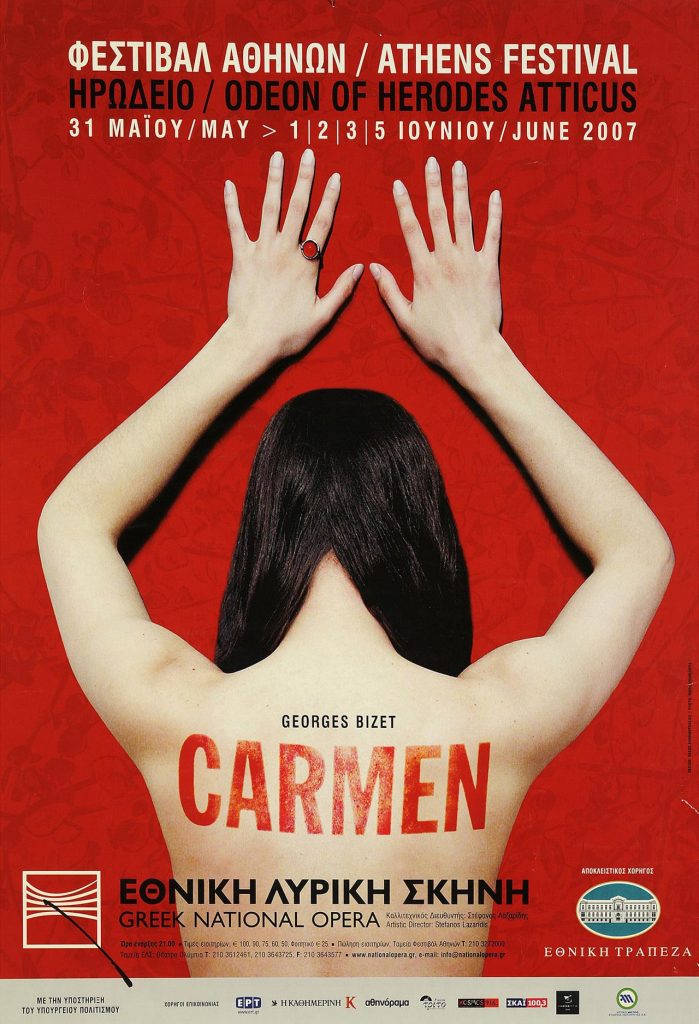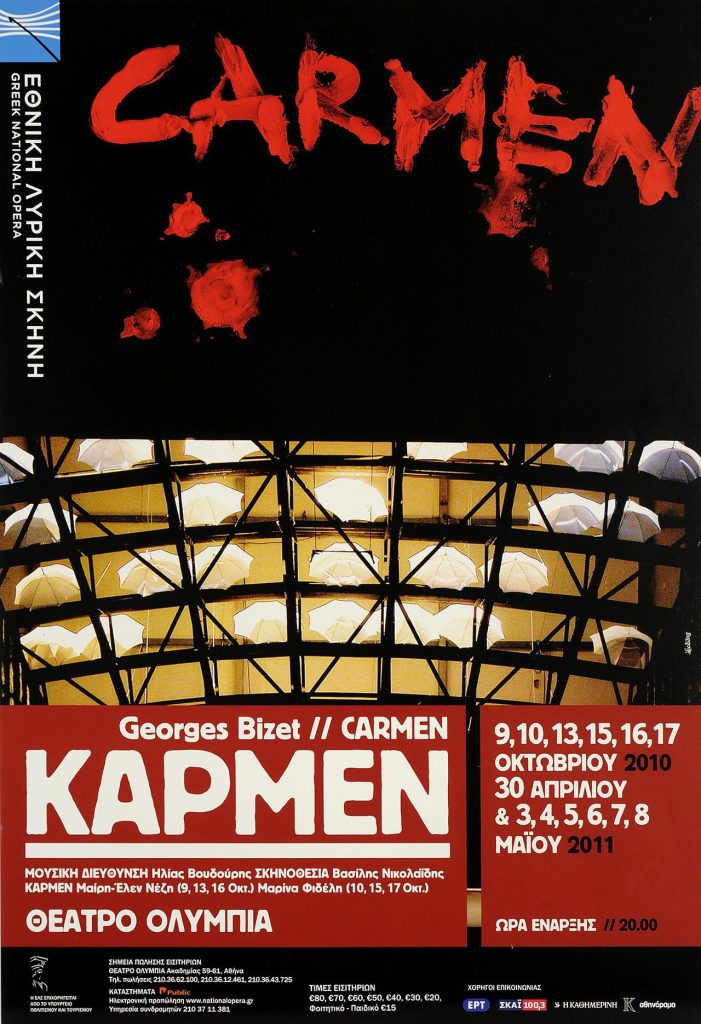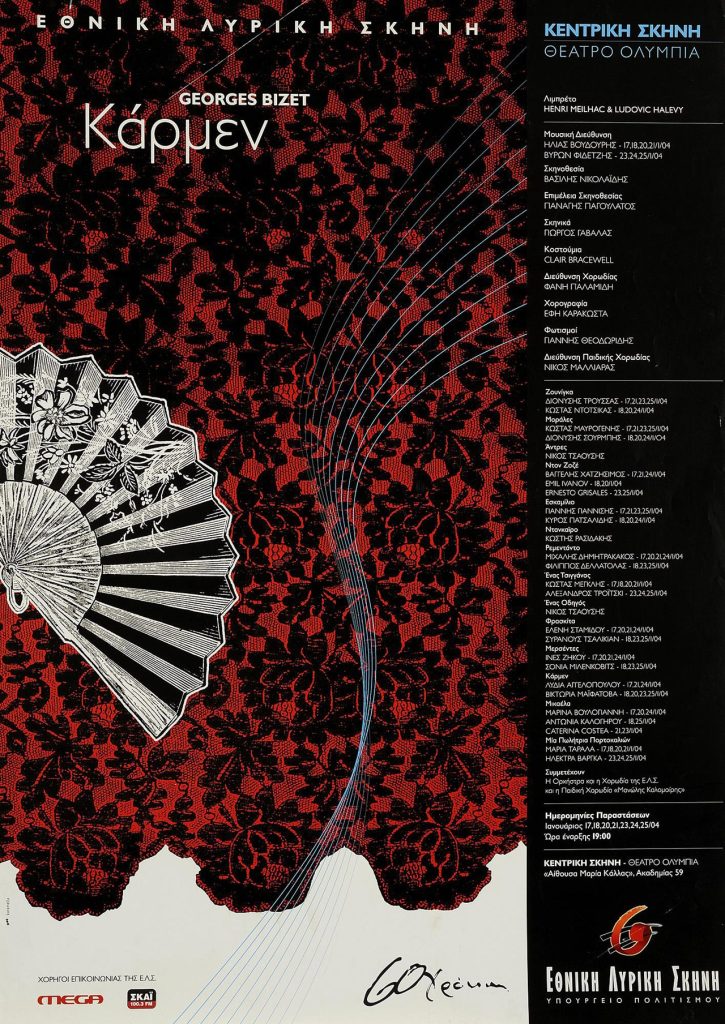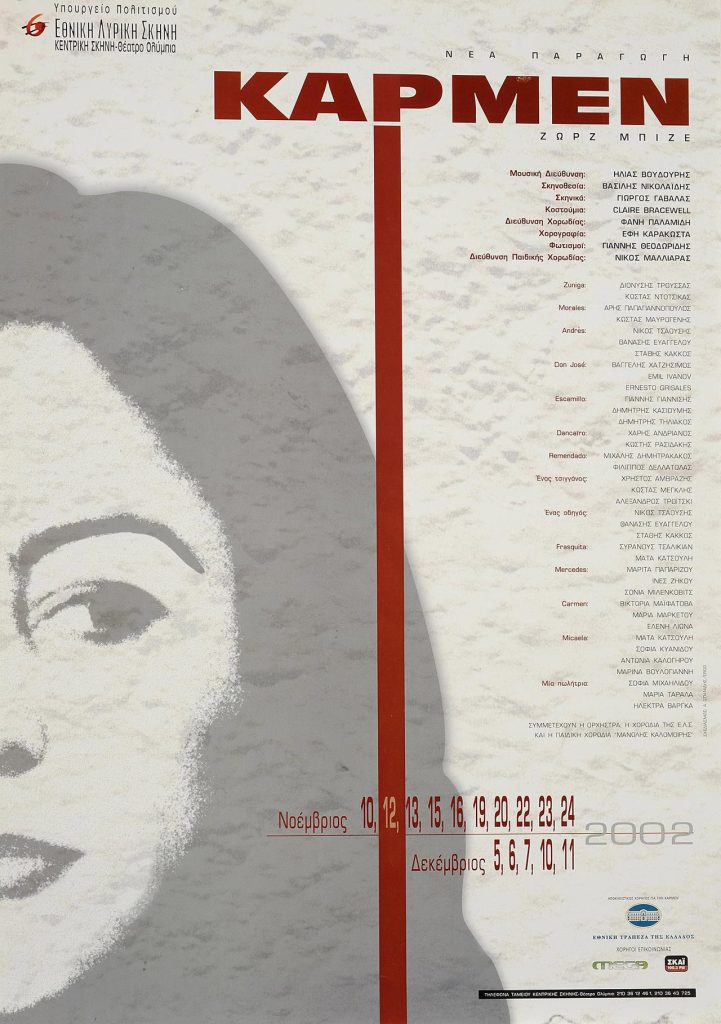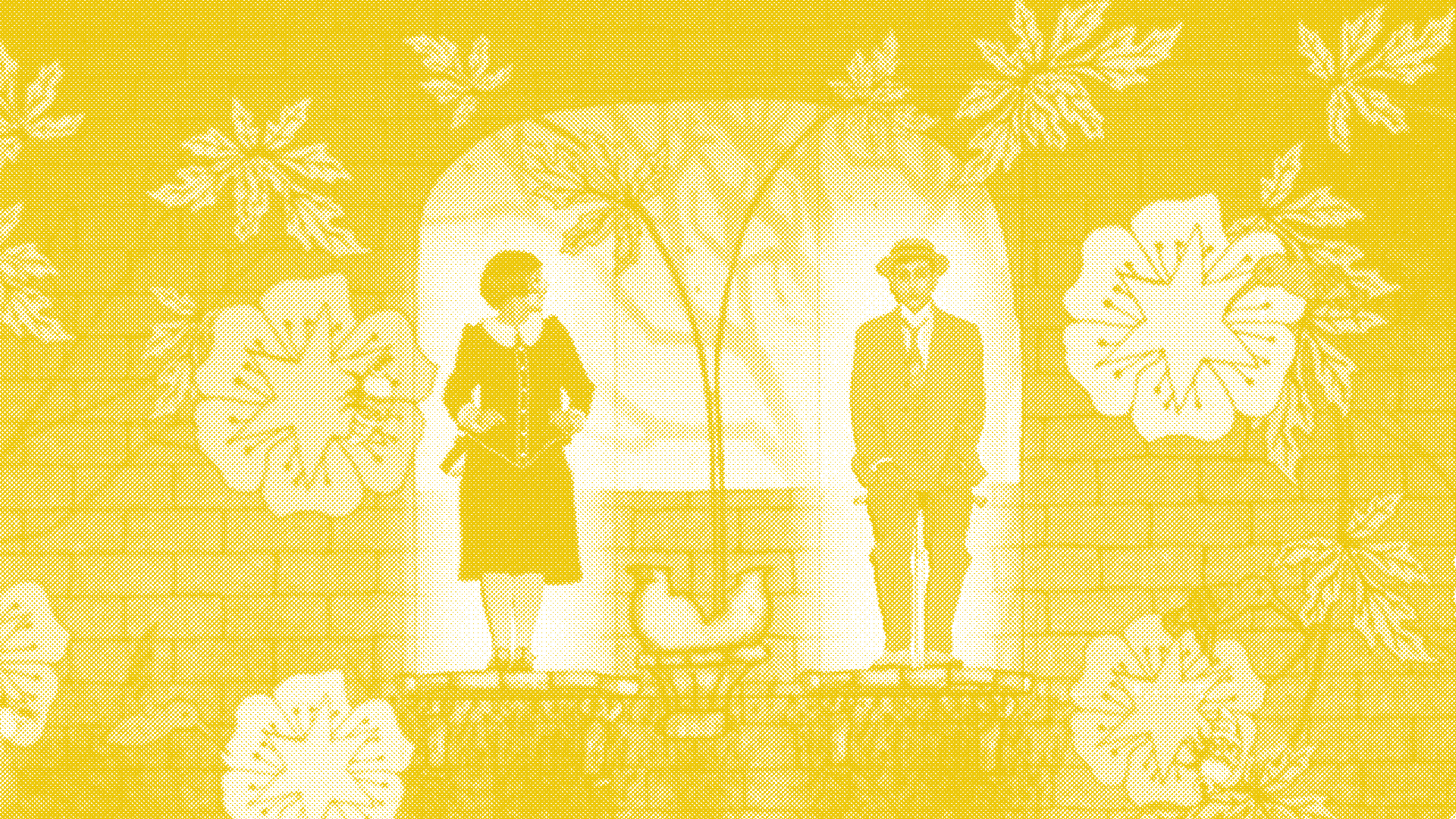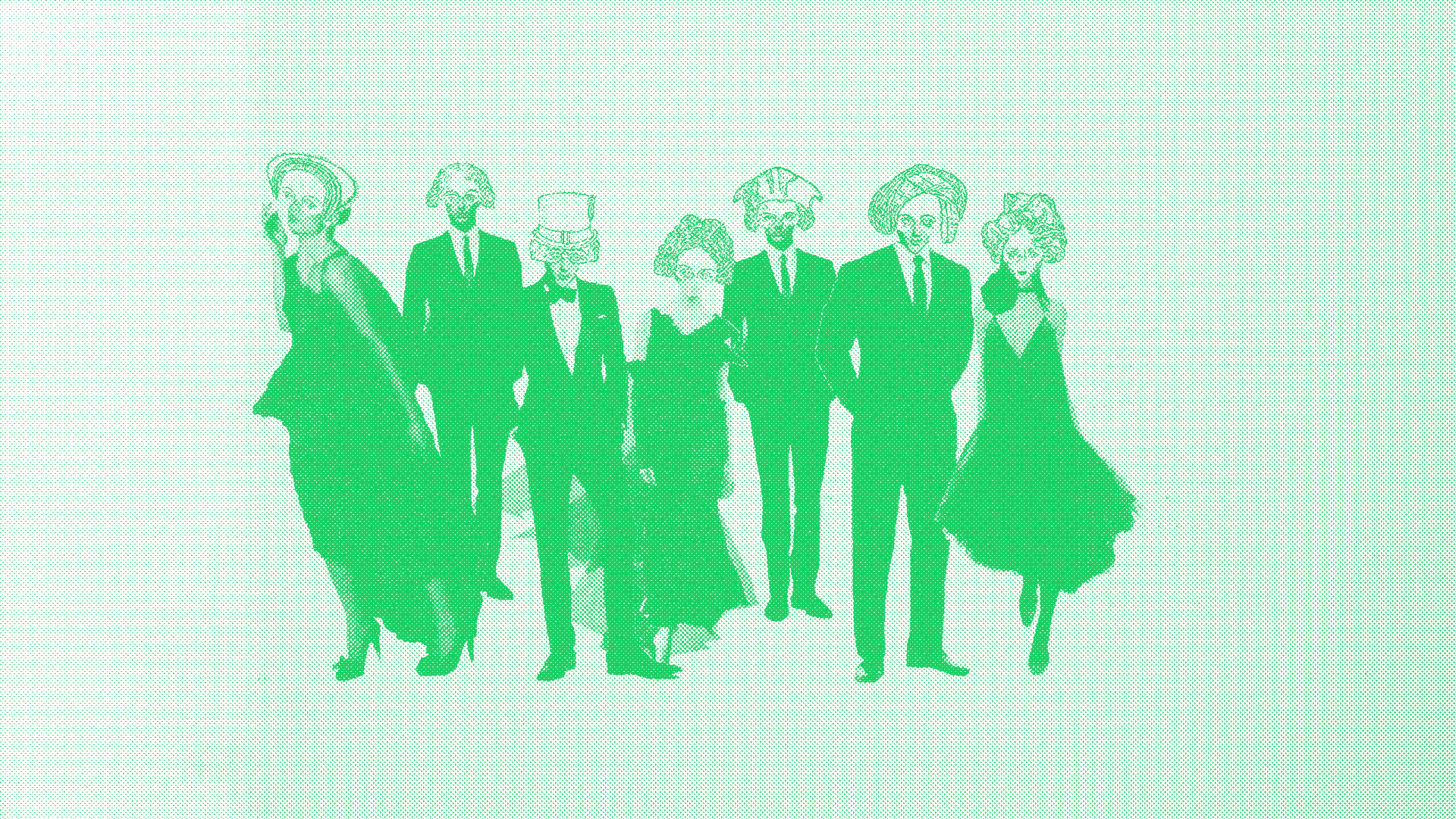
Voice types
and professions
in opera
CHAPTER 1 / INTRODUCTION
In this chapter you will find information regarding the types of voices encountered in opera. Have you ever heard the word “baritone”? If you haven’t, please read below! The conductor of Offenbach’s La belle Hélène describes the different roles of each profession, explaining the particularities of opera conducting.
Stathis Soulis, the conductor of Offenbach’s La belle Hélène describes the different roles of each profession, explaining the particularities of opera conducting.
The following texts are written by Artemis Ignatidou.
CHAPTER 2 / LOUD VOICES
After this long journey through the different aspects of opera, we couldn’t but save some space to talk about opera singers.
As opposed to most musician and singers of other genres, who begin their training from an early age, opera singers only begin their training after puberty. This delay allows their body to fully develop before they begin their demanding vocal training. In order to sing opera, singers need a strong diaphragm, a specific breathing technique, and of course the correct management of their nose, throat and mouth.
As you must surely have noticed already, opera singers do not usually use microphones in their performances. Part of their training focuses on the singing technique that allows an audience of thousands of people to hear their singing clearly even with the accompaniment of full a orchestra; they have been trained in such a way as to use their body as a natural amplifier.

GNO, Madama Butterfly by Giacomo Puccini. Conductor: Lukas Karytinos; Direction, set and costume desing: Hugo DeAna. GNO TV (2020)
CHAPTER 3 / VOCAL RANGE
Apart from the loud volume and the special technique required for opera singing, singers are also divided into different categories according to their vocal range. For a glimpse of the science behind the different vocal ranges you may look at physics, and more specifically the theory of sound waves and audio frequencies. The main categories of opera singers we have encountered in the different sections are:
Soprano
The highest female voice (c’ to c’’). Initially almost all female characters were written for soprano– with the exception of some supportive roles– but until the 18th century the term denoted the higher registers sung by ‘castrato’ singers or young boys. Women at the time sung at the vocal region we currently term ‘mezzo-soprano’.66S. Sadie 1992, The New Grove Dictionary of Opera, τ. 4, σ. 457-458. After 1800, the practice of composing roles with specific singers in mind was discontinued and soprano singers had to train in a wider variety of styles. As such, specialisations such as ‘coloratura’, ‘lyrical’, ‘dramatic’ or ‘heroic’ soprano emerged. In the 19th and 20th centuries, the requirements placed upon soprano singers were mainly affected by the compositional and aesthetic demands of creators such as Gioachino Rossini, Richard Wagner, Giacomo Puccini, Vincenzo Bellini, Gaetano Donizetti, Charles Gounod, Giuseppe Verdi, and Ruggero Leoncavallo, as well as emergent ‘national’ aesthetics.
George Frideric Handel, Xerxes. “Ombra mai fu”, Xerxe’s aria from the first act, soloist: Mary-Ellen Nesi. Olympia Theatre (2002/03).
Mezzo-soprano67Sadie, S., 2001 (2nd ed). The New Grove Dictionary of Music and Musicians, vol. 16, pp. 584- 587
The voice that sings in the region between the soprano and the alto voices (a – a”) and shares qualities with both. Initially the range where all female singers sang, the mezzo-soprano became an independent voice from the first half of the 18th century, when some composers began writing soprano parts that exceeded the traditional range of the general mezzo- soprano region. This development showed the special qualities in the texture of the mezzo-soprano region but also excluded singers from performing soprano roles. The voice of ‘mezzo-soprano’ was established firmly and many more roles were performed by specialised mezzo-sopranos, after the range of the soprano voice expanded further and ‘castrato’ singers disappeared from the operatic stage. From the 20th century mezzo-sopranos were further distinguished into ‘high’, ‘low’, ‘lyric’ or ‘dramatic’, highlighting in this way the nuanced textures and techniques in the interpretation of mezzo-soprano roles. Important composers, such as Jules Massenet and Richard Strauss composed roles especially for mezzo-sopranos while, during the past few decades, important mezzo-sopranos have interpreted cross-dressing, repertory roles.
Camille Saint-Saëns, Samson and Delilah. “Printems qui commence” Dalilah’s aria from the first act, soloist: Markella Hatziano. Odeon of Herodes Atticus (2002/03).
Alto / Contralto
The lowest of the female voices (f- f”). Historically overshadowed by the prominence of the soprano voices, alto singers usually perform supportive roles, such as servants, nannies, women of age, or male and comic roles. This fact doesn’t diminish the skill required to sing alto parts or make their contribution less important or beautiful. Composers such as Claudio Monteverdi, Georges Bizet, Camille Saint-Saëns, Giacomo Meyerbeer and many others composed arias that showcase the beauty of the alto voice. From the mid-20th century an increasing number of alto singers have used the designations ‘high’ or ‘low’ alto, with this change supported by the rising popularity of works by Gioachino Rossini and George Frideric Handel, who composed impressive arias for singers with a low singing texture.68S. Sadie 1992, The New Grove Dictionary of Opera, τ. 1, σ. 933-934.
Gioachino Rossini L’italiana in Algeri. “Cruda sorte” Isabella’s aria from the first act, soloist: Irini Karaianni. Olympia Theatre (2005/06).
Tenor
The highest of the male voices. A voice that played an important part in church and secular music during the Baroque period but sang mainly supportive or comic roles in the opera during the same period. After the Classical period tenor singers were casted as heroes or lovers while, even later, composers such as Gioachino Rossini, Vincenzo Bellini and Gaetano Donizetti created tenor roles with rich, dramatic qualities.69S. Sadie (επιμ.) 1988, The Grove Concise Dictionary of Music, σ. 759. After the disappearance of ‘castrato’ singers, tenors began enjoying wider recognition from the audience and, especially during the 20th century, they achieved stardom similar to that of the most beloved sopranos.
Σαρλ Γκουνό, Φάουστ, «Salut, demeure, chaste et pure», άρια του Φάουστ από την Γ΄ Πράξη, σολίστ: Αντρέι Ντουνάεφ, Μέγαρο Μουσικής Αθηνών (2011/12).
Baritone
The male voice that sings between the tenor and the bass voices. The term came into use from the 19th century onwards even though many roles had already been interpreted in this range since the 18th century. The establishment of the baritone voice contributed to the creation of new male characters. While traditionally tenors and ‘castrato’ singers interpreted the roles of heroes and lovers, and basses played kings, soldiers, and men of age, baritones were casted as romantic-rivals, brothers, young men, and young-acting older men.70O. Jander – J.B. Steane – E. Forbes – E.T. Harris – G. Waldman, «Baritone», στο: S. Sadie, New Grove Dictionary of Music and Musicians, τ. 2, σ. 731-732.
Giuseppe Verdi Rigoletto. “Pari siamo”, Rigoletto’s aria from the first act, soloist: Dimitris Platanias. Olympia Theatre (2008/09).
Bass
The deepest of the male voices [F- e’]. A vocal range in which roles such as that of the king, the sage, a deity, or an evil character are traditionally written. The bass region is significant in western art music in general, since the instruments that play in it support the melodic parts by providing the harmonic, structural element of music.
Giuseppe Verdi, Macbeth. “Come dal ciel precipita”, Banquo’s aria from the second act, soloist: Dimitri Kavrakos. Olympia Theatre (2002/03)
CHAPTER 4 / A VARIETY OF OTHER PROFESSIONS
Similarly to icebergs, whose visible tip is only a small percentage of their whole mass, the visible part of opera that we enjoy on stage is supported by a massive backstage operation.
And if this example is not particularly helpful let me try it this way: did you know that behind the main stage of the GNO there exists an equally large space, where sceneries are prepared and stored? And what about the dressing rooms for the singers, where are they located? Does anyone clean all the roses that the audience throws adoringly to sopranos or are they left on the stage and eventually grow into a rose garden?
While most operas last two or three hours, and then the musicians and the audience go home, the production of an opera is a big and complex operation that requires the successful collaboration of many art workers, artists who do not appear on stage, as well as administrational and managerial staff. Let’s visit the backstage spaces of the Greek National Opera in order to get acquainted with the different professions of the opera.
A walk through the backstage of the Greek National Opera, a short video with excerpts from the technical rehearsal of the opera Le Voyage dans la Lune by Jacques Offenbach, Conductor: Elias Voudouris, Director, costumes: Laurent Pelly, Stavros Niarchos Hall, 2023 (video produced by OddBleat).
After watching the above video, write a list with all the different professions that could be involved in the production of an opera. Do the professions on your list match to those in the following list?
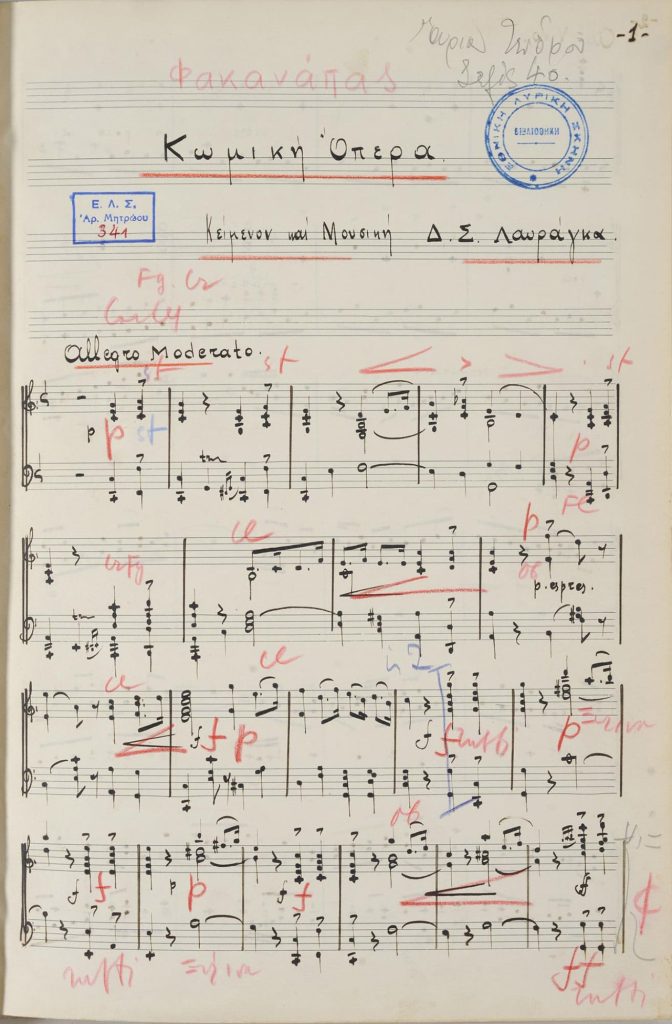
Vocal score for the comic opera Fakanapas by Dionysios Lavrangas, Greek National Opera (1950/51).
Composer
the creator of the music.
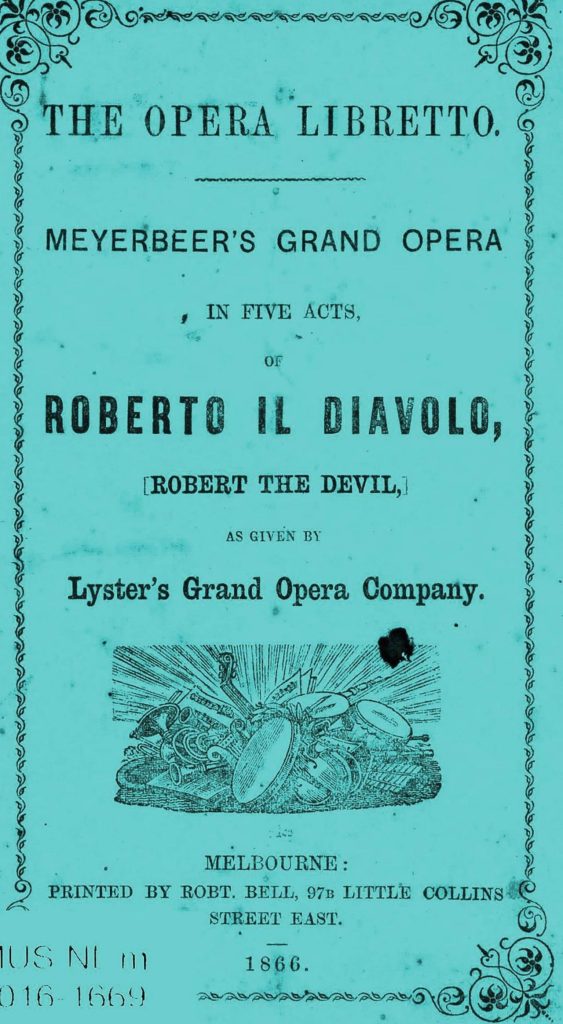
The cover of the libretto for the opera Robert le diable by Giacomo Meyerbeer, Public domain, via Wikimedia Commons.
Librettist
the author of an operatic script. The librettist writes the libretto, which is the full text of the opera. It includes the dialogues, the lyrics of the arias and the recitative, it describes the plot, and gives staging directions. A libretto can be written especially for a new composition, it can pre-exist as a poem, it can be written in collaboration with a composer, or even by a composer.
Director
the person responsible for imagining and overseeing the realization of an opera on stage. They work closely with the set designer, the costume designer, the lighting designer, the singers and the rest of the production team in order to bring an opera to life.
Set designer
the person responsible for imagining, designing, and overseeing the production of stage scenery.
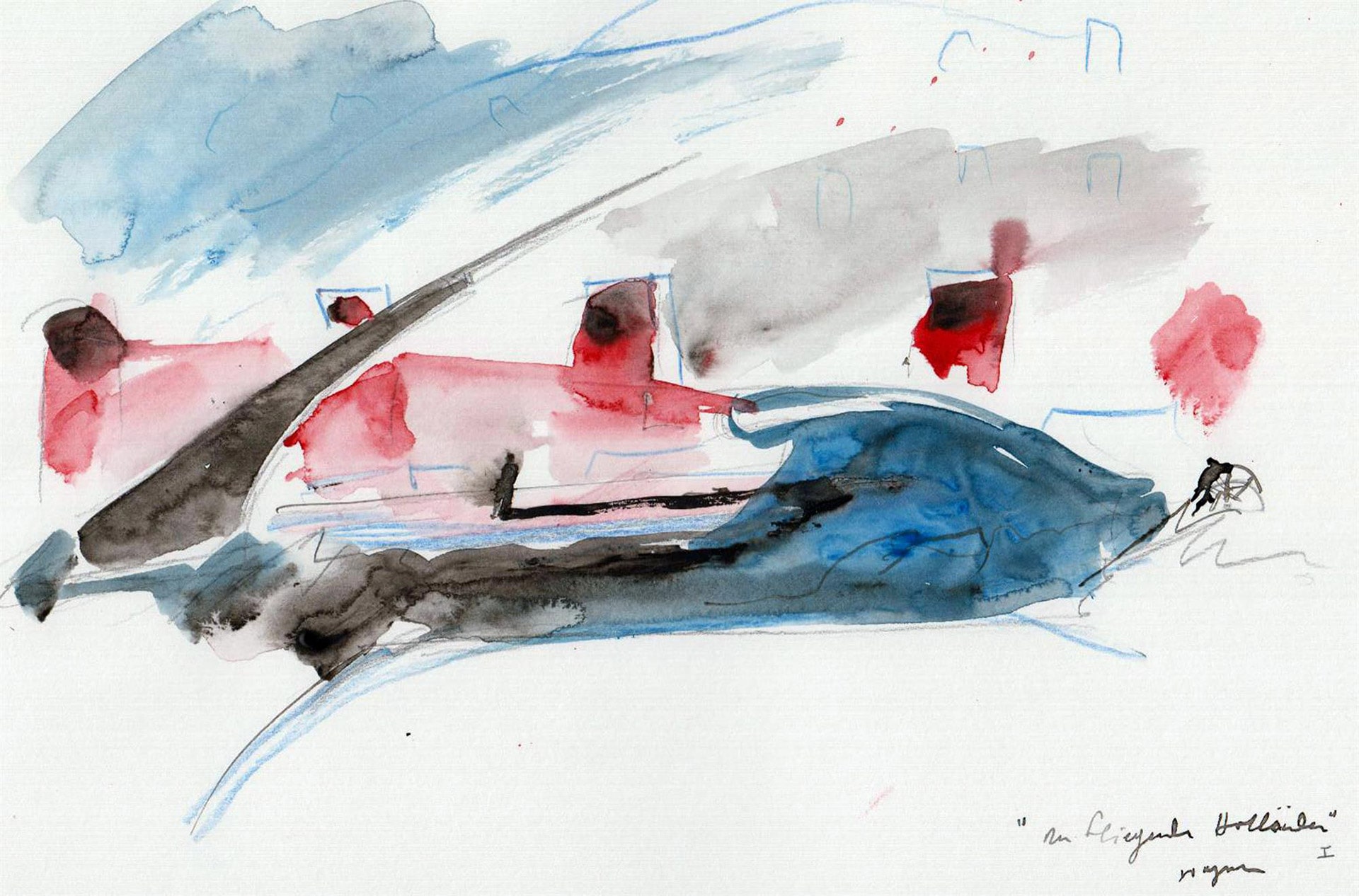
General impression of the stage view for the first act of Richard Wagner’s Der Fliegende Holländer, by set designer Yannis Kokkos, Odeon of Herodes Atticus, (2012/13).
Singers
the performers of the opera. They are musicians who specialise in singing, with long training and experience in the genre of opera.

The Tales of Hoffmann by Jacques Offenbach. A coproduction of the Greek National Opera and The Royal Theatre La Monnaie in Brussels. Conductor: Lukas Karytinos; stage direction: Krzysztof Warlikowski; sets and costumes: Małgorzata Szczęśniak. Stavros Niarchos Hall of the Greek National Opera (2022/23)
Orchestra musician
a musician, member of the orchestra, participating in the musical interpretation of an opera.
Set-design constructor
a person responsible for building all of the scenery for a production of opera.
Stage mechanic
a person responsible for the moving parts of the stage scenery.
Lighting Designer
the person responsible for the correct lighting of the stage; they work in collaboration with the director and the set designer to ensure singers can be seen clearly and to create special effects.
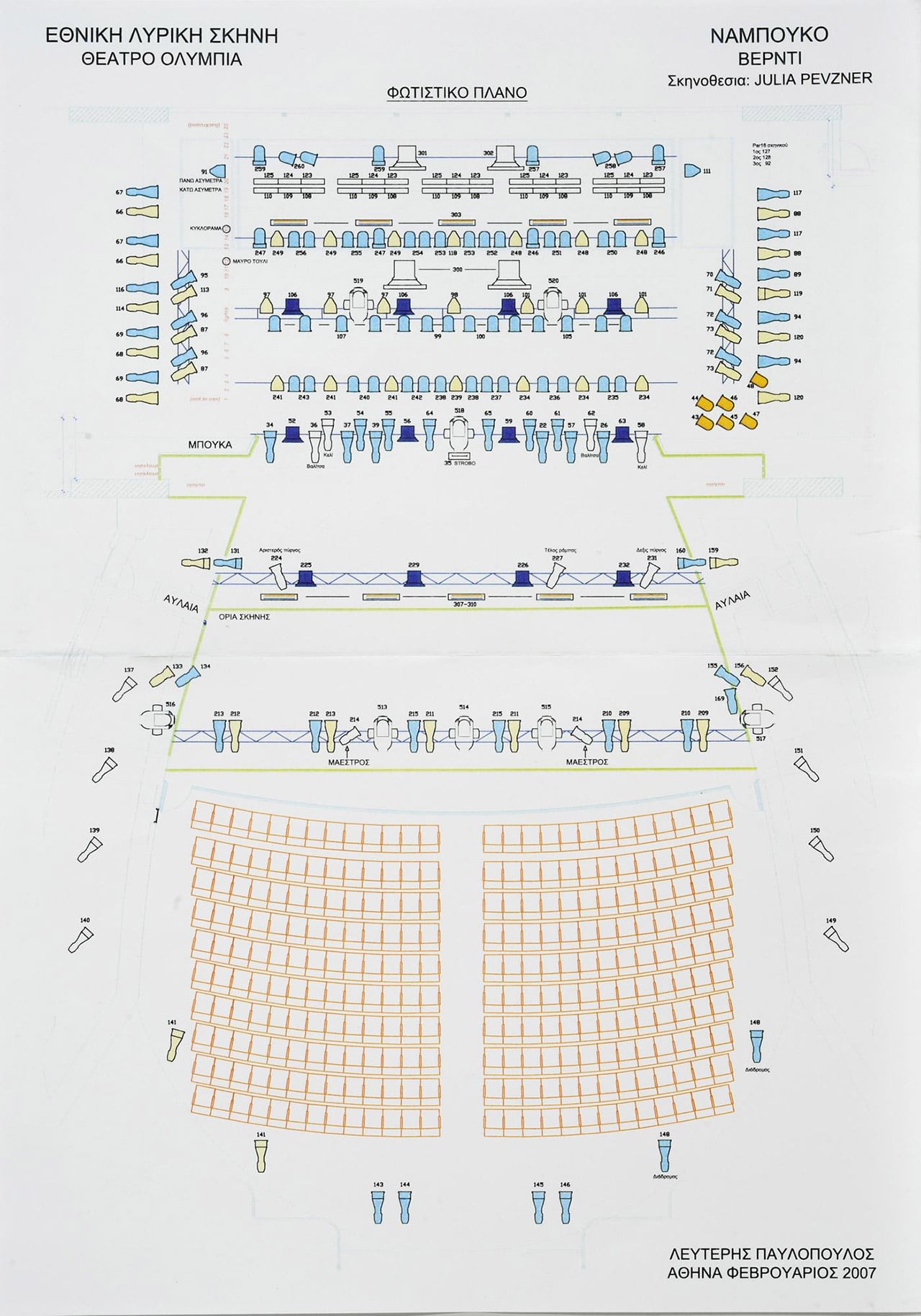
Lighting design by set designer Antonis Daglidis for the opera Nabucco by Giuseppe Verdi, Olympia Theatre, (2007/08)
Prop Master
the person responsible for the acquisition, creation and management of the objects used by singers on stage (props), as well as their placement on stage.
Head of hair and makeup
the person responsible for imagining and designing the hairstyle and makeup of the opera’s characters.
Costume designer
the person who imagines and designs or orders the costumes, and oversees their preparation for a production.
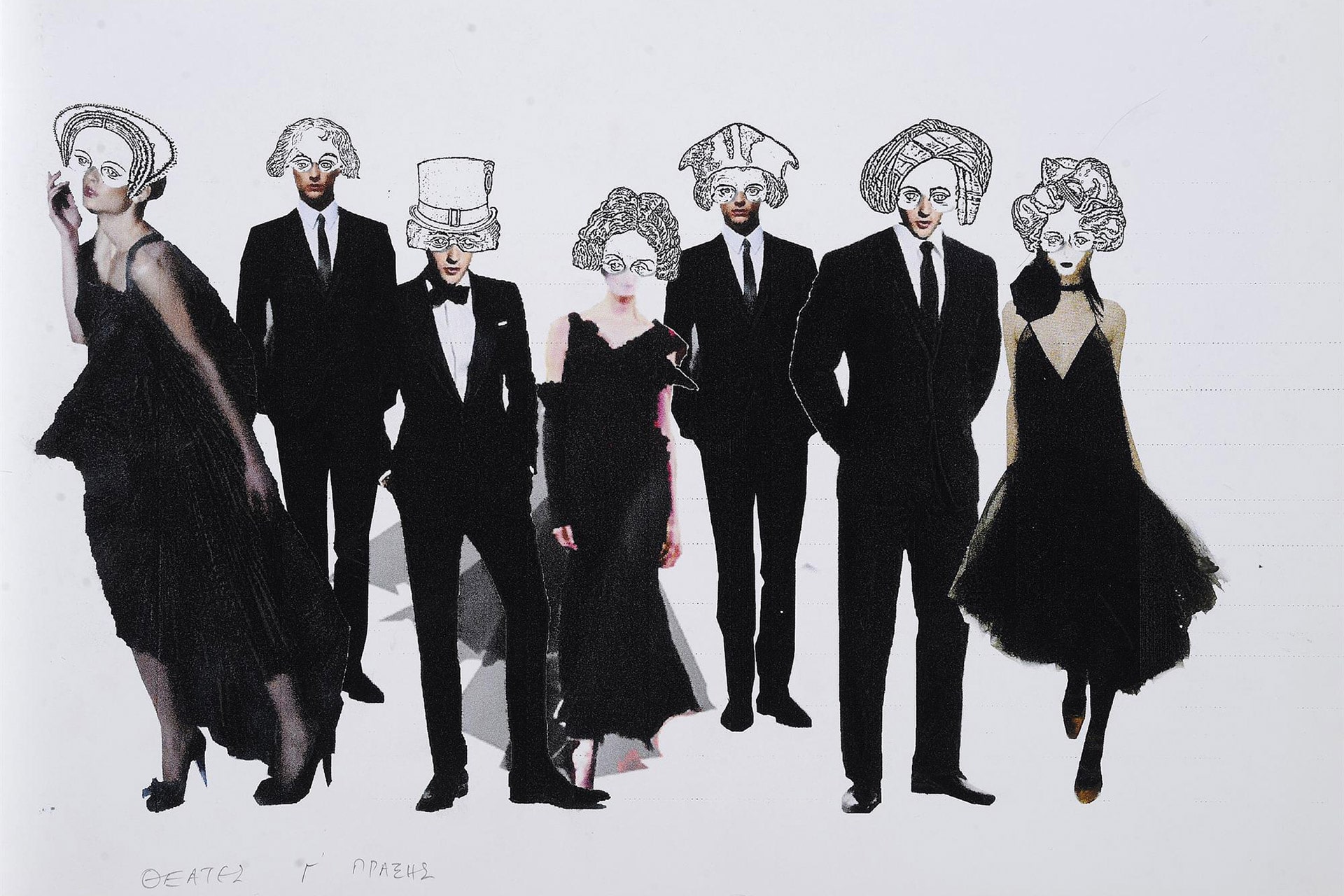
Costumes by designer Eleni Manolopoulou for the opera ‘Una ballo in maschera’ by Giuseppe Verdi, Olympia Theatre (2011/12).
Tailor / Seamstress
a person responsible for creating the costumes for a performance.
Répétiteur
a musician who rehearses – and sometimes coaches– opera singers and members of the opera choir.
Choreographer
the person who devises the dancing parts of the opera and oversees the dancers’ training.
Dancers
the performer of the dance parts of the work.
Chorus master
the person responsible for teaching the chorus of the opera.
Conductor
the person responsible for the musical interpretation of the work, and the musical direction of the orchestra, the singers, and the choir during the performance of an opera.

Kyriaki Kountouri, conductor of the opera Offenbach’s La belle Hélène by Kornilios Selamsis, while conducting the orchestra, Greek National Opera (2023), photo by Valeria Isaeva.
Cinematographer
the person responsible for creating a video version of the staged work.
Makeup Artist
the person responsible for applying the singers’ makeup in preparation for an opera performance.
Backstage footage from the production of the opera The Magic Flute by Wolfgang Amadeus Mozart. Conductors: Zoi Tsokanou & Georgios Balatsinos; directors: Suzanne Andrade & Barrie Kosky; revival director: Tobias Ribitzki; animation: Paul Barritt. Stavros Niarchos Hall, 2018
Administrative staff
the members of staff who support productions by organizing the logistics, communications, marketing, human resources, finances, and every other practical aspect of a production.
Producer
the ‘general manager’ responsible for coordinating the collaboration between all members of an opera production.
Sets storage and archiving staff
the members of staff responsible for storing the sets of past productions safely.
Cleaner
a person responsible for keeping the opera house, including the stage, the backstage, and the auditorium clean.
Usher
a person facilitating the audience showing people to their seats
Communication and promotion
And of course, a whole team of professionals in charge of promoting the performance.
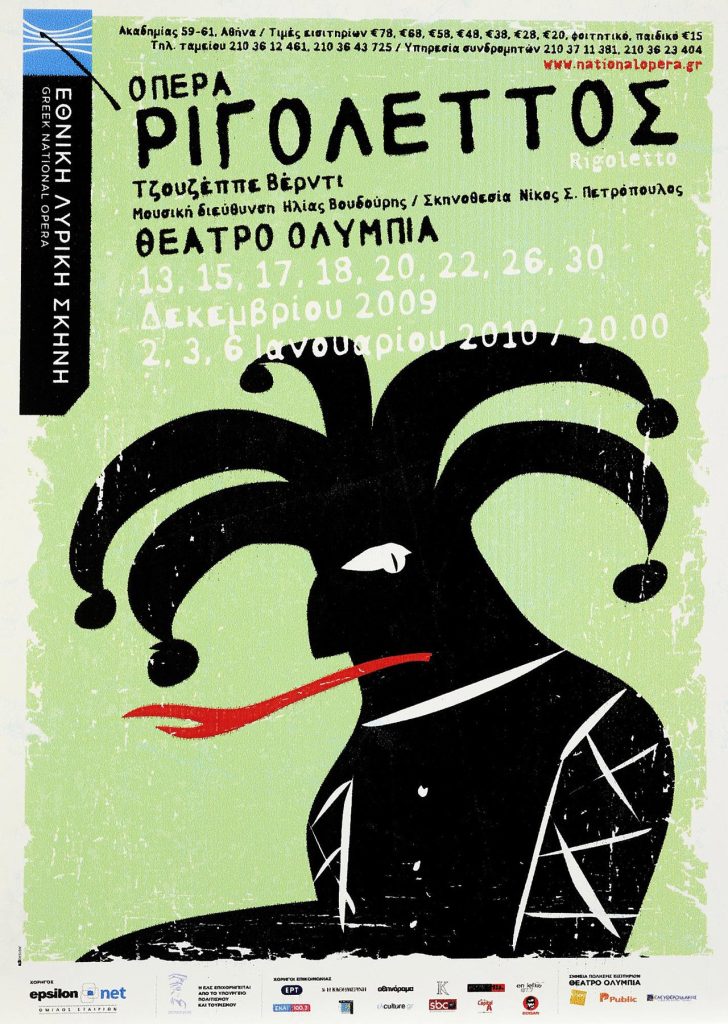
Poster for the GNO production of Giuseppe Verdi‘s Rigoletto, Olympia Theatre, 2009/10
QUIZ / VOICE TYPES AND PROFESSIONS IN OPERA
ACTIVITIES / VOICE TYPES AND PROFESSIONS IN OPERA
Introduction
The rehearsals and preparations for Carmen are advancing rapidly. Only a few months are left before the opera’s premiere in your city and you need to run the communication campaign for the show. Create the poster, post excerpts and video teasers on social media, and anything else you can imagine, to guarantee a full house at your premiere.
In this activity imagine that, apart from being members of the artistic team, you are also responsible for communicating Carmen’s production. In what direction would you like to steer your Carmen? In what way will you attract a larger audience?
Connection to the curriculum
– Greek literature
– Art class
– Informatics
– Music
Main themes
– Communications and the marketing of a performance
– Text production
– Graphic design
– Video production
Suggested duration
4 teaching hours
Educational objectives
– Understanding the cross-art nature of opera
– Development of communications skills
– Development of critical thinking skills
– Development of creativity
– Promotion of collaborative practices (in the classroom)
Step 1
Read the following summary of the opera Carmen:
The story is set in Seville, c.1830. Carmen is a Gypsy tobacco factory worker who has a strong love and faith in man’s free nature. In a gathering at the factory, while Carmen is singing and entertaining her admirers, she throws a flower to Don José, a lieutenant of the guard, who becomes enraptured by her temperament. When Carmen will later on be involved in a fight with another worker and will use a knife to assault her, Don José will have to arrest her and lead her to prison. Carmen, however, through the use of her charm and promises of love, manages to convince Don José to let her go. After a while, Carmen meets the bullfighter Escamillo, who is captivated by Carmen and hopes to win her love. Meanwhile, Don José is released from prison, where he was being held for setting Carmen free. When he meets Carmen, he tells her that he will leave the military for her sake. She, on the other hand, seems to remain unaffected. The two men, Don José and Escamillo, persistently pursue Carmen, yet she wants her freedom. The story ends in the arena of Seville, where Carmen arrives together with Escamillo. Don José begs her to follow him, but Carmen tells him that she doesn’t love him and that she prefers to die than lose her freedom, and gives him back the ring he had gifted her. As Escamillo strikes down the bull in the arena, Don José stabs Carmen to death.
Step 2
Watch the following two excerpts from George Bizet’s Carmen, directed by Stephen Langridge. In this production the action takes place in today’s society. In this way the director aspired to show the timelesness of the opera.
Promotional trailer for the GNO production of George Bizet’s Carmen. Conductor: Lukas Karytinos; stage direction: Stephen Langridge; set & costume design: George Souglides. Odeon of Herodes Atticus, 2018
Step 3
Discuss different versions of Carmen in the classroom. Where would you place the action? Can you think of an idea that would be attractive to audiences or help the work’s promotion? Who would be ‘Carmen’ where you live?
Step 4
In this final step you will create the promotional material for your own version of Carmen. After deciding on the time and place where your opera takes place, split into two groups. The first group will write the texts and the second group will design the visual material for your media campaign. See below a suggested to-do list for each team:
Texts
– Title and a short description of the opera
– A detailed press release including the following:
• The names of the cast and production members (Conductor, Director, Set designer, Costume designer, Lighting designer, Chorus master, Orchestra & Choir members, Singers, Choreographer, etc.)
• A detailed description of the opera, which could also include an introduction by the director
• Information about the dates, the times, and the venue of the performance
• Ticket prices
Images
– A poster (this should comprise an image and some basic information about the performance)
– An edited version of the poster for social media use
– A short video (teaser) for social media use
In the following link you can find the texts and the online poster for the most recent GNO production of Bizet’s Carmen:
https://www.nationalopera.gr/en/archive/productions-archive/season-2015-2016/item/2094-carmen
As you can see in the following video, the promotional video of a performance may not always include excerpts from it. In this promotional video, for example, there are only sound excerpts from Bizet’s Carmen. Therefore you can let your imagination run wild and create a video for your own performance, without including the characters, the costumes or the stage design of your opera.
Short promotional video for the GNO production of George Bizet’s Carmen. Conductor: Lukas Karytinos; stage direction: Stephen Langridge; set & costume design: George Souglides. Odeon of Herodes Atticus, 2016
Below you will see a selection of posters from different productions of Carmen, where each creative team gave its own interpretation for the promotion of their performance. Nevertheless, in all of them red is the predominant colour.
Why do you think this is the case? Would you choose another colour for the poster of your own Carmen?
